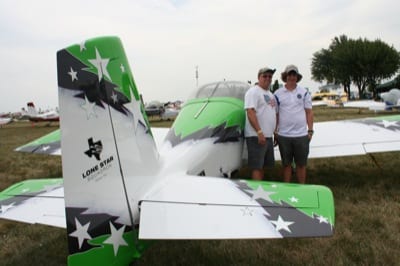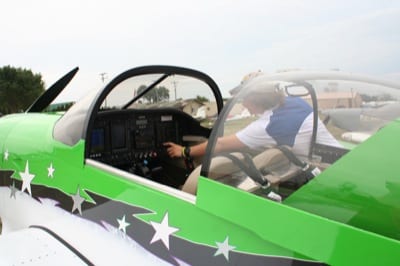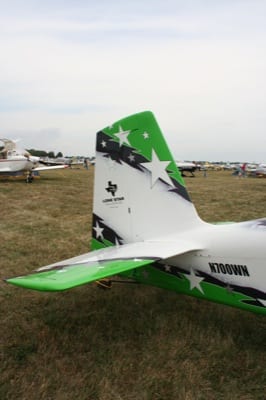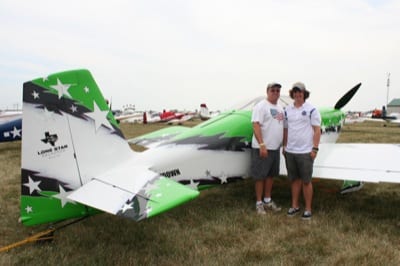Transitioning from flying a Cessna 152 to an RV-7 is a lot like learning to drive in the family station wagon, then getting a Porsche. You can’t help but envy the guys who get to do it. Scott Sundstrom from Friendswood, Texas, had that very experience just in time for last summer’s AirVenture. Scott, accompanied by his father Steven, made the trip to the annual show in the RV-7 they’d just finished building.
“The airplane has a total of 105 hours on it,” said Steven Sundstrom, proudly noting that Scott had put 40 to 50 hours of that time on the airframe.
 “It took us about five and a half years to build, but it was worth it,” Scott chimed in, noting that, in addition to getting a slick airplane to fly at the end of the project, he also learned how to read plans and “be patient.”
“It took us about five and a half years to build, but it was worth it,” Scott chimed in, noting that, in addition to getting a slick airplane to fly at the end of the project, he also learned how to read plans and “be patient.”
“I build model airplanes too,” he said. “The real thing is much more fun in the end — it just takes longer!”
Steven is an airline pilot and Scott is considering a similar career path. For that reason, the Sundstrom RV-7 was designed to enable quality time-building.
 “Van’s makes a product that does everything well,” Steven explained, adding that it was important to get an airplane with side-by-side seating. In addition to Scott, Sundstrom’s wife flies and he has another son who enjoys aerobatics.
“Van’s makes a product that does everything well,” Steven explained, adding that it was important to get an airplane with side-by-side seating. In addition to Scott, Sundstrom’s wife flies and he has another son who enjoys aerobatics.
One of the most difficult parts of building the airplane was deciding on the engine.
“It has an IO-360 200 horsepower,” he said. “I bought it at SUN ’n FUN three years ago. The seller offered me a deal that I just couldn’t pass up.”
The engine gets 180 knots in cruise and burns 9.10 gallons per hour, he noted. “It gets pretty good range,” he added.
One of the selling points of the RV is the plethora of builder assistance, both in person and online. The Sundstroms had the help of a man who had built three RVs and was experienced with electronics. He persuaded the elder Sundstrom to create a panel that was more high tech.
“When I was learning to fly it was very basic needle, ball, airspeed,” Sundstrom explained. “Flying up here from Texas was the airplane’s longest trip so far. I found stuff on the panel I haven’t figured how to use yet!”
For the younger Sundstrom, the transition between the docile tricycle-gear C-152 and the tailwheel RV was a challenge.
 “The RV is a lot harder to land than a Cessna 152,” Scott said. “The taildragger is a lot harder to handle on the ground. You really have to pay attention because everything happens faster in the RV.”
“The RV is a lot harder to land than a Cessna 152,” Scott said. “The taildragger is a lot harder to handle on the ground. You really have to pay attention because everything happens faster in the RV.”
Of all the homebuilt aircraft on the market, the Van’s products seem to inspire the most camaraderie among owners. There are several RV squadrons around the country that promote excellence in airmanship and formation flying. The Sundstroms are part of the Lone Star Squadron, started about 10 years ago by pilots in Houston.
“We do a lot of formation flying and the $200 hamburger,” Steven said. “It was wonderful being able to join the group. There is a big difference between watching them fly and being able to fly with them. They are very inspiring.”
The insignia of the squadron is emblazoned on the RV-7’s tail. It’s the crowning touch on the Sundstrom airplane, which is green on white with black accents. The design, which looks like a banner fluttering the afternoon breeze, was done by John McFarland at Airborne Kustomz out of Giddings, Texas.
“I didn’t want an airplane that was plain vanilla, with just a couple of stripes. I wanted something eye catching,” Steven said. “I had seen the designer’s work on the Internet. His shop is about 100 miles from my home, so one day after a hamburger run I stopped in on him. I had a vision of a scheme that was sort of a ribbon. Then he came up with a paint scheme and I said ‘I don’t like that, but what about this?’ And we went back and forth on it maybe four or five times until we came up with a scheme we both liked. I wanted my wife to sign off on it. I told her ‘if you like it, I like it’ and she liked it.”
When designing a color scheme, McFarland presents aircraft owners with three to eight options, including main color and accent colors.
“Originally Mr. Sundstrom wanted something in red and black, but a black airplane can get a little warm,” McFarland said. “I was able to show him something he liked in Kawasaki green.”
 Once the customer has picked the colors, McFarland works up a digital sketch, followed by a computer-generated three-dimensional rendering. “The challenge of painting a taildragger is imaging what it is going to look like in level flight,” he said.
Once the customer has picked the colors, McFarland works up a digital sketch, followed by a computer-generated three-dimensional rendering. “The challenge of painting a taildragger is imaging what it is going to look like in level flight,” he said.
The project includes fiberglass work, because if the airplane is rough, the best paint in the world won’t look good on it.
“Very few of them are ready to paint,” McFarland said. “Some need as much as 40 hours of body work. You need to prep the fiberglass, then lay down the primer so you know what you will get when the project is finished.”
McFarland is particularly proud of how the Sundstrom airplane turned out.
“Even when it is sitting still, it looks like it has some forward momentum,” he said.
